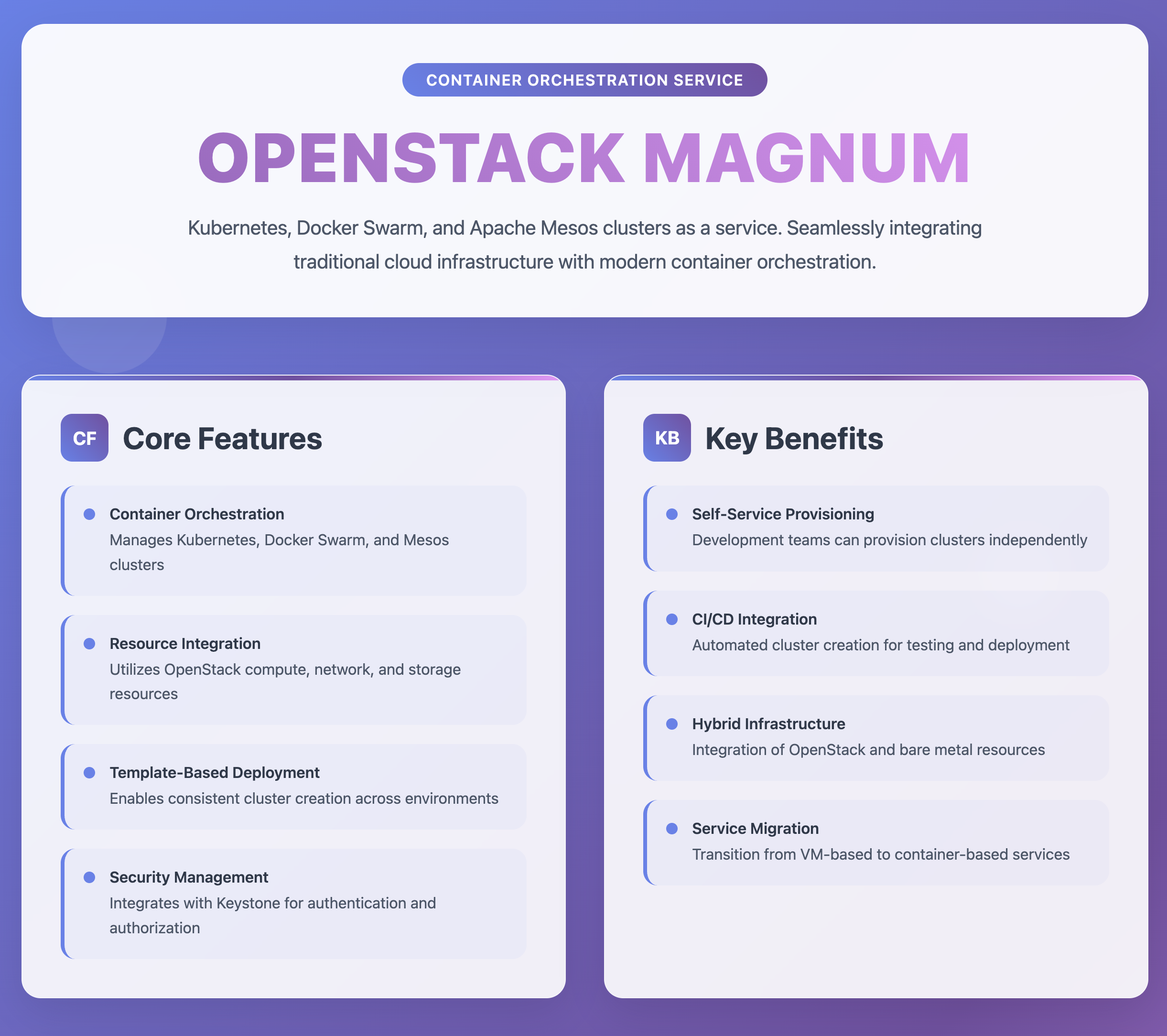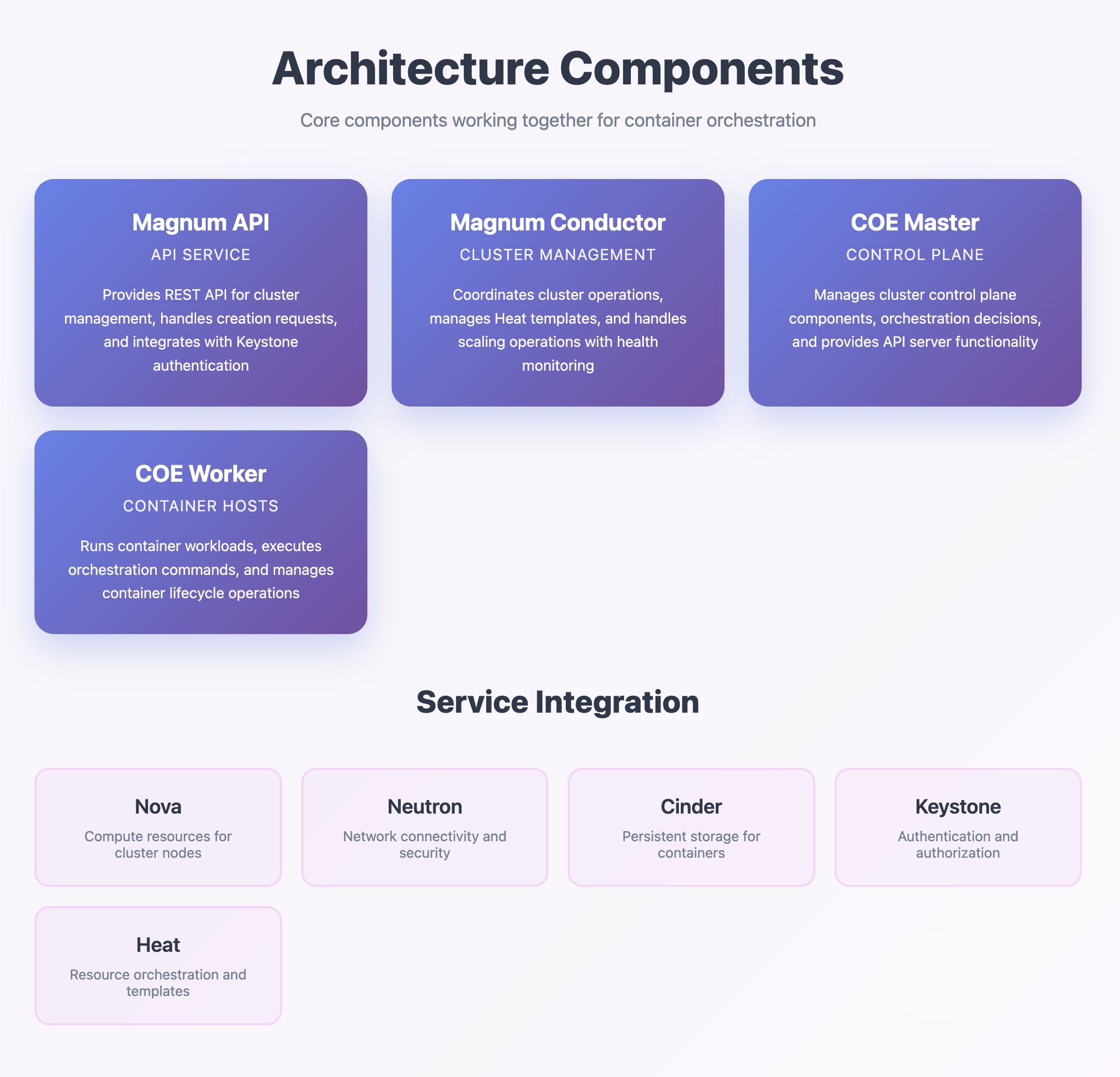7 min to read
Deep Dive into OpenStack Magnum
Understanding OpenStack's Container Orchestration Service

Understanding OpenStack Magnum
Magnum is OpenStack’s container orchestration service that provides Kubernetes, Docker Swarm, and Apache Mesos clusters as a service.
It leverages OpenStack resources (Nova, Neutron, Cinder) to create and manage container clusters, offering a seamless integration between traditional cloud infrastructure and modern container orchestration.
What is Magnum?
The Container Orchestration Service
Magnum serves as OpenStack’s container orchestration service, providing essential functionality:
- Container Orchestration: Manages Kubernetes, Docker Swarm, and Mesos clusters
- Resource Integration: Utilizes OpenStack compute, network, and storage resources
- Template-Based Deployment: Enables consistent cluster creation across environments
- Security Management: Integrates with Keystone for authentication and authorization
By providing container orchestration capabilities, Magnum bridges the gap between traditional cloud infrastructure and modern container-based applications.
Magnum Architecture Overview (Diagram Description)
- Core Features: COE Support, Template Management, Resource Control
- Service Integration: Nova, Neutron, Cinder, Keystone, Heat
- Cluster Management: Cluster Creation, Node Management, Scaling
- Security: Authentication, Authorization, Network Security

Advanced Configuration (Production Hardening)
Cluster Template Matrix
| Requirement | Recommendation | Notes |
|---|---|---|
| Kubernetes Versioning | Track upstream LTS; validate per OpenStack release | Pin image tags; document upgrade path |
| Network | Calico/Cilium for policy; Neutron integration | Define CIDRs, MTU, encapsulation |
| Storage | CSI with Cinder/CEPH RBD | Pre-create StorageClasses and defaults |
| Ingress | NGINX/Contour ingress controllers | Expose LBaaS config via template labels |
Performance & Scaling
- Right-size master/worker flavors; separate etcd from control-plane on larger clusters
- Enable cluster autoscaler; set min/max node counts per AZ
- Prefer containerd; tune kubelet eviction thresholds and image GC
- Use NodeLocal DNS cache; align MTU across Neutron and CNI
High Availability (HA)
| Layer | Recommendation | Notes |
|---|---|---|
| Control Plane | 3 masters, external etcd (or stacked with quorum) | Spread across fault domains |
| Workers | Multiple node groups per AZ | Enable Pod Disruption Budgets |
| Load Balancing | Octavia LBaaS for API/ingress | Health checks, idle timeouts |
Security & Compliance
- Keystone-integrated auth; map projects to cluster templates/quotas
- Enforce CIS benchmarks (Kubernetes hardening) via template labels/addons
- Use private images and signed artifacts; pin images for determinism
- Network policies default-deny; restrict service types and LB exposure
Observability & Operations
- Install Prometheus/Grafana, metrics-server, and cluster/etcd alerts by default
- Centralize logs (Loki/ELK); include audit logs from API server
- Define SLOs: API availability, deploy success rate, scale latency
- Backup etcd and critical addons; document restore runbooks
CI/CD for Cluster Templates
- Validate Heat/ClusterTemplate changes in CI (lint, render, dry-run)
- Canary a small cluster on upgrades; run conformance tests (Sonobuoy)
- Maintain compatibility matrix of Magnum/OpenStack vs Kubernetes versions
Troubleshooting Playbook (Quick Checks)
- Cluster CREATE_FAILED: Check Heat stack events, image/glance availability, Neutron quotas
- Nodes Not Ready: Verify cloud-init completion, kubelet logs, Neutron ports/DHCP
- CNI Issues: Confirm CNI DaemonSet status, MTU alignment, security groups
- LB Failing: Inspect Octavia health, listener rules, security groups/subnets
Magnum Architecture and Components
Magnum’s architecture consists of several key components that work together to provide container orchestration capabilities.
Each component plays a specific role in cluster management and resource allocation.
Core Components
| Component | Role | Description |
|---|---|---|
| Magnum API | API Service |
|
| Magnum Conductor | Cluster Management |
|
| COE Master | Control Plane |
|
| COE Worker | Container Hosts |
|
Service Integration
Magnum integrates with several OpenStack services:
- Nova: Provides compute resources for cluster nodes
- Neutron: Manages network connectivity and security
- Cinder: Provides persistent storage for containers
- Keystone: Handles authentication and authorization
- Heat: Manages resource orchestration and templates
This integration enables comprehensive container orchestration within the OpenStack ecosystem.
Key Features and Capabilities
Magnum provides comprehensive container orchestration capabilities that enable effective cluster management and resource utilization.
These features make it a powerful tool for container-based application deployment.
Core Features
| Feature | Description | Benefits |
|---|---|---|
| COE Support | Multiple container orchestration engines |
|
| Template Management | Cluster configuration templates |
|
| Resource Control | OpenStack resource management |
|
Best Practices
Key considerations for Magnum deployment:
- Image Management: Keep cluster OS images updated with latest Kubernetes versions
- Network Design: Implement proper network isolation between clusters
- Security Configuration: Optimize security groups for master and worker nodes
- Logging Strategy: Implement centralized logging (ELK stack)
- Monitoring Setup: Deploy Prometheus and Grafana for cluster monitoring
- Update Planning: Design update strategy considering rolling upgrade limitations
These practices ensure reliable and maintainable container orchestration.
Implementation and Usage
Effective implementation of Magnum requires proper configuration and integration with other OpenStack services.
Here are key considerations and best practices for utilizing Magnum effectively.
Common Operations
| Operation | Description | Command |
|---|---|---|
| Cluster Creation | Create new container cluster | openstack coe cluster create |
| Cluster List | List available clusters | openstack coe cluster list |
| Node Scaling | Scale cluster nodes | openstack coe cluster resize |
Use Cases
Magnum is particularly useful for:
- Development Environments: Self-service cluster provisioning for development teams
- CI/CD Integration: Automated cluster creation for testing and deployment
- Hybrid Clusters: Integration of OpenStack and bare metal resources
- Service Migration: Transition from VM-based to container-based services
These use cases demonstrate Magnum's flexibility and integration capabilities.
Key Points
-
Core Functionality
- Container orchestration service
- Multiple COE support
- OpenStack resource integration
- Template-based deployment -
Key Features
- Cluster management
- Resource control
- Security integration
- API access -
Best Practices
- Image management
- Network design
- Security configuration
- Monitoring setup


Comments